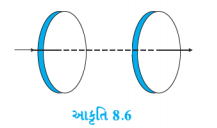Use the formula λmT=0.29 cm K to obtain the characteristic temperature ranges for different parts of the electromagnetic spectrum. What do the numbers that you obtain tell you ? Solution in Gujrati
A body at temperature T produces a continuous spectrum of wavelengths. For a black body, the wavelength corresponding to maximum intensity of radiation is given according to Wein’s law by the relation: λm=0.29cmK/T. For λm=10−6m,T=2900K. Temperatures for other wavelengths can be found. These numbers tell us the temperature ranges required for obtaining radiations in different parts of the electromagnetic spectrum. Thus, to obtain visible radiation, say λ=5×10−7m, the source should have a temperature of about 6000 K.
Note: a lower temperature will also produce this wavelength but not the maximum intensity.
Topper's Solved these Questions
- ELECTROMAGNETIC WAVESBOOK - NCERT GUJARATICHAPTER - ELECTROMAGNETIC WAVESEXERCISE - EXERCISES
10 Videos
- ELECTROMAGNETIC INDUCTIONBOOK - NCERT GUJARATICHAPTER - ELECTROMAGNETIC INDUCTIONEXERCISE - ADDITIONAL EXERCISES
7 Videos
- ELECTROSTATIC POTENTIAL AND CAPACITANCE BOOK - NCERT GUJARATICHAPTER - ELECTROSTATIC POTENTIAL AND CAPACITANCE EXERCISE - EXERCISES
35 Videos
Similar Questions
Figure 8.6 shows a capacitor made of two circular plates each of radius 12 cm, and separated by 5.0 cm. The capacitor is being charged by an external source (not shown in the figure). The charging current is constant and equal to 0.15A.
(a) Calculate the capacitance and the rate of change of potential difference between the plates.
(b) Obtain the displacement current across the plates.
(c) Is Kirchhoff’s first rule (junction rule) valid at each plate of the capacitor? Explain.

View SolutionSuppose the loop is stationary but the current feeding the electromagnet that produces the magnetic field is gradually reduced so that the field decreases from its initial value of 0.3 T at the rate of 0.02 T s−1. If the cut is joined and the loop has a resistance of 1.6 Ω, how much power is dissipated by the loop as heat ? What is the source of this power ?
View SolutionTwo charges 5×10−8 C and −3×10−8 C are located 16 cm apart. At what point(s) on the line joining the two charges is the electric potential zero? Take the potential at infinity to be zero.
View SolutionUse the formula λmT=0.29cmK to obtain the characteristic temperature ranges for different parts of the e.m. spectrum. What do the number that you obtain tell you?
View SolutionThe terminology of different parts of the electromagnetic spectrum is given in the text. Use the formula E = h ν (for energy of a quantum of radiation: photon) and obtain the photon energy in units of eV for different parts of the electromagnetic spectrum. In what way are the different scales of photon energies that you obtain related to the sources of electromagnetic radiation?
View Solutionem वर्णक्रम के विभिन्न भागों के लिए लाक्षणिक ताप परिसरों कों ज्ञात करने के लिए λmT=0.29cmK सुत्र का उपयोग कीजिए। जो संख्याऐ आपको मिलती हैं वे क्या बतलाती हैं।
View Solutionem वर्णक्रम के विभिन्न भागो के लिए लाक्षणिक ताप परिसरों को ज्ञात करने के लिए λmT=0.29 सेमी K सूत्र का उपयोग कीजिए । जो संख्याएँ आपको मिलती हैं, वे क्या बताती हैं ?
View Solutionविद्युतचुम्बकीय नणक्रम के विभिन्न भागों के लिए लाक्षणिक ताप परिसरों को ज्ञात-करने के लिए λmT=0.29 सेमी०-केल्विन सूत्र का उपयोग कीजिए। जो संख्याएँ आपको मिलती हैं वे क्या बतलाती हैं?
View SolutionThe terminology of different parts of the electromagnetic spectrum is given in the text. Use the formula E = hv (for energy of a quantum of radiation: photon) and obtain the photon energy in units of eV for different parts of the electromagnetic spectrum. In what way are the different scales of photon energies that you obtain related to the sources of electromagnetic radiation ?
View SolutionUse the formula λmT=0.29 cm K to obtain the characteristic temperature ranges for different parts of the electromagnetic spectrum. What do the numbers that you obtain tell you ?
View SolutionUse the formula λmT=0.29 cm K to obtain the characteristic temperature ranges for different parts of the electromagnetic spectrum. What do the numbers that you obtain tell you ?
View SolutionThe terminology of different parts of the electromagnetic spectrum is given in the text. Use the formula E = hν (for energy of a quantum of radiation: photon) and obtain the photon energy in units of eV for different parts of the electromagnetic spectrum. In what way are the different scales of photon energies that you obtain related to the sources of electromagnetic radiation?
View SolutionUse the formula λmT=0.29 cm K to obtain the characteristic temperature ranges for different parts of the electromagnetic spectrum. What do the numbers that you obtain tell you?
View SolutionThe terminology of different parts of the electromagnetic spectrum is given in the text. Use the formula E = hν (for energy of a quantum of radiation: photon) and obtain the photon energy in units of eV for different parts of the electromagnetic spectrum. In what way are the different scales of photon energies that you obtain related to the sources of electromagnetic radiation?
View SolutionUse the formula λ_(m) T = 0.29 cm K to obtain the characteristic temperature ranges for different parts of the electromagnetic spectrum. What do the numbers that you obtain tell you?
View SolutionThe terminology of different parts of the electromagnetic spectrum is given in the text. Use the formula E = hν (for energy of a quantum of radiation: photon) and obtain the photon energy in units of eV for different parts of the electromagnetic spectrum. In what way are the different scales of photon energies that you obtain related to the sources of electromagnetic radiation?
View Solution